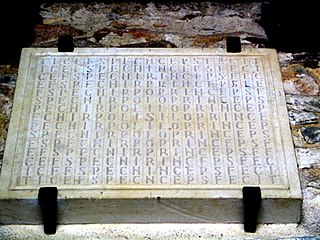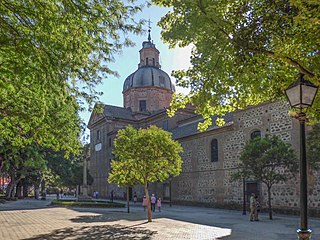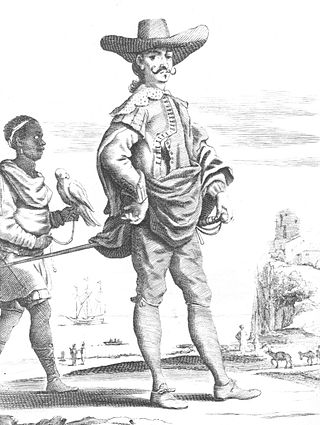Related Research Articles

Toledo is a city and municipality of Spain, the capital of the province of Toledo and the de jure seat of the government and parliament of the autonomous community of Castilla–La Mancha.
Castile or Castille is a territory of imprecise limits located in Spain. The use of the concept of Castile relies on the assimilation of a 19th-century determinist geographical notion, that of Castile as Spain's centro mesetario with a long-gone historical entity of diachronically variable territorial extension.

Pelagius was a Hispano-Visigoth nobleman who founded the Kingdom of Asturias in 718. Pelagius is credited with initiating the Reconquista, the Christian reconquest of the Iberian Peninsula from the Moors, and establishing the Asturian monarchy, making him the forefather of all the future Iberian monarchies, including the Kings of Castile, the Kings of León, and the Kings of Portugal.

The Battle of Covadonga took place in 722 between the army of Pelagius the Visigoth and the army of the Umayyad Caliphate. Fought near Covadonga, in the Picos de Europa, it resulted in a victory for the Christian forces of Pelagius. It is traditionally regarded as the foundational event of the Kingdom of Asturias and thus the initial point of the Christian Reconquista ("reconquest") of Spain after the Umayyad conquest of 711.

The Battle of Guadalete was the first major battle of the Muslim conquest of the Iberian Peninsula, fought in 711 at an unidentified location in what is now southern Spain between the Visigoths under their king, Roderic, and the invading forces of the Umayyad Caliphate, composed mainly of Berbers and some Arabs under the commander Tariq ibn Ziyad. The battle was significant as the culmination of a series of Berber attacks and the beginning of al-Andalus. Roderic was killed in the battle, along with many members of the Visigothic nobility, opening the way for the capture of the Visigothic capital of Toledo.

Silo was the king of Asturias from 774 to 783, succeeding Aurelius. He came to the throne upon his marriage to Adosinda, daughter of Alfonso I. He moved the capital of the Kingdom of Asturias from Cangas de Onís to Pravia, closer to the center of the kingdom. He was a contemporary of Abd al-Rahman I, Umayyad Emir of Córdoba, and of Charlemagne.

Talavera de la Reina is a city and municipality of Spain, part of the autonomous community of Castile–La Mancha. Its population of 83,303 makes it the second most populated municipality of the province of Toledo and the fourth largest in the region.
Íñigo Arista was a Basque chieftain and the first king of Pamplona. He is thought to have risen to prominence after the defeat of local Frankish partisans at the Battle of Pancorbo in 816, and his rule is usually dated from shortly after the defeat of a Carolingian army in 824.
García Íñiguez I, also known as García I was the second king of Pamplona from 851–2 until his death. He was the son of Íñigo Arista, the first king of Pamplona. Educated in Cordoba, he was a successful military leader who led the military campaigns of the kingdom during the last years of his father's life.

Alfonso Fróilaz, called the Hunchback, was briefly the king of the unified kingdom of Asturias, Galicia and León in 925. He succeeded his father, King Fruela II, in July 925 but was driven from the throne within the year by his cousins Sancho, Alfonso IV and Ramiro II, the sons of his uncle, Ordoño II. He was restored to a royal position in part of the kingdom after Alfonso IV took power in 926, but was violently deposed and forced into a monastery in 932.

An hidalgo or a fidalgo is a member of the Spanish or Portuguese nobility; the feminine forms of the terms are hidalga, in Spanish, and fidalga, in Portuguese and Galician. Legally, an hidalgo is a nobleman by blood who can pass his noble condition to his children, as opposed to someone who acquired his nobility by Royal grace. In practice, hidalgos enjoyed important privileges, such as being exempt from paying taxes, having the right to bear arms, having a coat of arms, having a separate legal and court system whereby they could only be judged by their peers, not being subject to the death sentence unless it was authorized by the King, etc.

Ildefonsus or Ildephonsus was a scholar and theologian who served as the metropolitan Bishop of Toledo for the last decade of his life. His Gothic name was Hildefuns. In the Ethiopian Orthodox Tewahedo Church he is known as Dexius based on the Ge'ez translation of legends about his life.

The National Archaeological Museum is a archaeology museum in Madrid, Spain. It is located on Calle de Serrano beside the Plaza de Colón, sharing its building with the National Library of Spain. It is one of the National Museums of Spain and it is attached to the Ministry of Culture.

The designation artede (la) repoblación was first proposed by José Camón Aznar in 1949 to replace the term Mozarabic as applied to certain works of architecture from the Christian kingdoms of northern Spain between the end of the 9th and beginning of the 11th centuries. Camón argued that these buildings were related stylistically to the architecture of Asturias and owed little to Andalusian styles. Moreover, since they were built by Christians living under Christian rule, neither were they Mozarabic.

José Orlandis Rovira was a Spanish Roman Catholic priest and historian who wrote more than 200 works, including 20 books.

Hispania was the Roman name for the Iberian Peninsula. Under the Roman Republic, Hispania was divided into two provinces: Hispania Citerior and Hispania Ulterior. During the Principate, Hispania Ulterior was divided into two new provinces, Baetica and Lusitania, while Hispania Citerior was renamed Hispania Tarraconensis. Subsequently, the western part of Tarraconensis was split off, initially as Hispania Nova, which was later renamed "Callaecia". From Diocletian's Tetrarchy onwards, the south of the remainder of Tarraconensis was again split off as Carthaginensis, and all of the mainland Hispanic provinces, along with the Balearic Islands and the North African province of Mauretania Tingitana, were later grouped into a civil diocese headed by a vicarius. The name Hispania was also used in the period of Visigothic rule.

Claudio Sánchez-Albornoz y Menduiña was a Spanish scholar, politician and orator. He served as Prime Minister of the Spanish Republican government in exile during the dictatorship of Francisco Franco.

Sampiro (c. 956 – 1041) was a Leonese cleric, politician, and intellectual, one of the earliest chroniclers of post-conquest Spain known by name. He was also the Bishop of Astorga from 1034 or 1035 until his death.

The Battle of Monte Laturce, also known as the second Battle of Albelda, was a victory for the forces of Ordoño I of Asturias and his ally García Íñiguez of Pamplona. They defeated the latter's uncle and former ally, the Banu Qasi lord of Borja, Zaragoza, Terrer, and Tudela, Navarre, Musa ibn Musa al-Qasawi, a marcher baron so powerful and independent that he was called by an Andalusi chronicler "The Third King of the Spains" (Spaniae). The battle took place during the Asturian siege of a new fortress under construction by Musa at Albelda de Iregua. The fortress was taken a few days after the battle. After Monte Laturce, Musa was forced to fully submit to the Emir of Córdoba, who took advantage of Musa's weakness to remove him as wāli of the Upper March, initiating a decade-long eclipse of the Banu Qasi.
The regimiento, cabildo de regidores or concejo cerrado was a system of local government established from the 14h century onwards in the Crown of Castile. A feature of the progressive oligarchization of the form of government in the cities, the change from the overruled concejo abierto system entailed a reduction of the government to a relatively small number of regidores. Urban oligarchies intended to fully capture the nomination of the regidores since the beginning. The bulk of the establishment of the new regime chiefly took place between 1345 and the later years of the reign of Alfonso XI of Castile.
References
Notes
- ↑ Stocking, 336.
- ↑ Kulikowski, 415 n55.
- ↑ Payne, 13.
- ↑ Stocking, 341. For a brief discussion of the fidelis regis in 7th-century Spain, see Castellanos (2003).
- ↑ Stocking, 343.
- ↑ unanimidad internacional en adjetivar de protofeudal a la formación social y política encarnada por el Reino de Toledo a principios del siglo VIII, from Collins (2004), 4, citing Moreno (1992), 17.
- ↑ Kulikowski, 301.
Sources
- Castellanos, Santiago (2003). "The Political Nature of Taxation in Visigothic Spain." Early Medieval Europe, 12, pp. 201–28.
- Castellanos, Santiago and Viso, Iñaki Martín (2005). "The Local Articulation of Central Power in the North of the Iberian Peninsula (500–1000)." Early Medieval Europe, 13 (1), pp. 1–42.
- Collins, Roger J. H. (1984). "Late Antiquity and the Early Middle Ages." Annual Bulletin of Historical Literature, 68 (1), pp. 32–41.
- Collins, Roger J. H. (2004). Visigothic Spain, 409–711. Oxford: Blackwell Publishing. ISBN 0-631-18185-7
- Kulikowski, Michael (2004). Late Roman Spain and Its Cities. JHU Press. ISBN 0-8018-7978-7.
- Moreno, L. García (1992). "El estado protofeudal visigodo: precedente y modelo para la Europa carolingia" in: J. Fontaine and Christine Pellistrandi (edd.), L'Europe héritière de l'Espagne wisigothique. Madrid, pp. 17–43.
- Payne, Stanley G. (1973). A History of Spain and Portugal, Vol. 1. Milwaukee: University of Wisconsin Press.
- Stocking, Rachel L. (2007). "Review article: Continuity, culture and the state in late antique and early medieval Iberia." Early Medieval Europe, 15 (3), pp. 335–348.